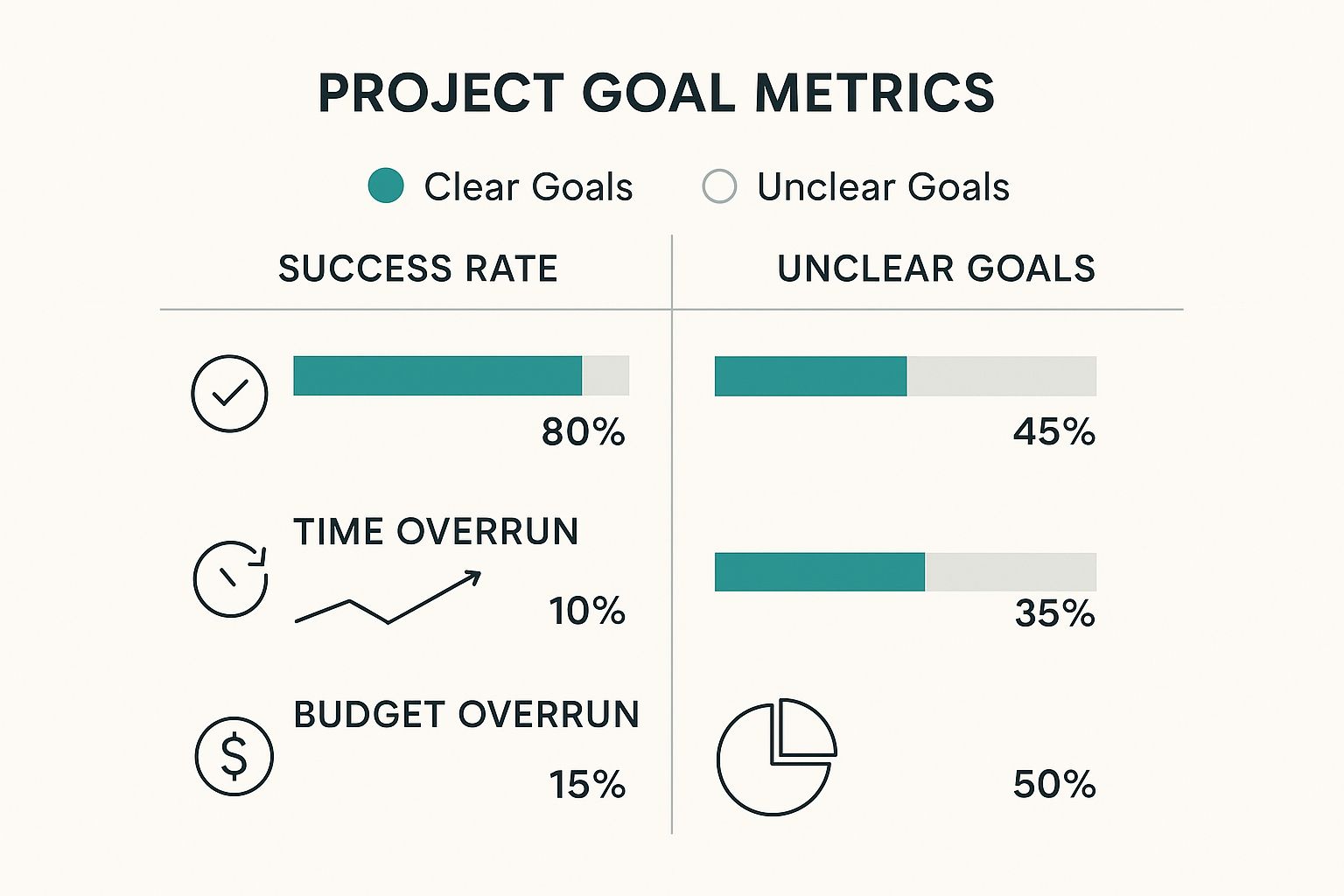For most founders, project management isn't some rigid corporate process. It's the simple art of breaking a huge idea into a string of small, manageable wins. It's the system that turns your grand vision into what you actually do day-to-day, making sure you’re building real momentum instead of just staying busy.
Why Project Management Is Your Startup's Secret Weapon

As a founder, you're not just the CEO—you're the marketer, the developer, and the janitor. In that beautiful chaos, project management is your best defense against the two things that kill startups most often: wasted resources and blown deadlines. It's what gives you the clarity to see through the fog of just getting started.
Without some kind of structure, it's dangerously easy to burn your precious time on tasks that don't move the needle or chase shiny objects that don’t line up with your real goals. This is exactly where so many promising ventures get stuck.
From Chaos to Control
Let's get real. Imagine you're launching a new feature. With no plan, you might dive into coding for a week, only to realize you completely forgot to design the user interface. So you pivot, spend two days on design, and then discover a critical flaw in your logic that forces you to scrap half the code you already wrote. That kind of reactive cycle absolutely crushes your time and morale.
Now, picture a different way. You set up a simple board with three columns: "To Do," "In Progress," and "Done." You break that feature launch into bite-sized tasks:
- Draft user stories and requirements.
- Create wireframes for the UI.
- Develop the back-end logic.
- Build the front-end components.
- Test everything for bugs and usability.
This organized flow makes sure every step builds on the last. No more expensive rework, just focused progress. If you want to dive deeper, you can explore more of these essential project management fundamentals.
Aligning Daily Tasks With Your Vision
Good project management isn't just about ticking off boxes on a to-do list; it’s about strategic alignment. This is what separates founders who succeed from those who just spin their wheels.
Consider this: roughly 80% of project managers agree that tying projects directly to business objectives is what makes them successful. And when you realize that poor project performance wastes nearly 10% of every dollar invested, the financial argument becomes impossible to ignore.
A good system doesn’t just tell you what to do next; it tells you why you're doing it. It connects that small task you’re working on today directly to the long-term vision you have for your company. This connection is what fuels sustainable motivation and drives real progress.
Finding a Project Management Style That Actually Works
Let's be real for a second. Forget the dense textbooks and rigid corporate frameworks you hear about. For a solo founder, the best project management style isn't the most complex or the most popular—it's the one you will actually use day in and day out.
The goal here isn't to wrap your startup in red tape. It's to find a simple, practical system that brings clarity and momentum to your daily hustle. What works for a founder grinding on a SaaS product is going to look completely different from what a creator needs to manage their content pipeline. The key is being honest about how you work best.
Choosing a method is less about the tool and more about your own psychology and workflow. For a deeper look into this, check out this insightful piece on aligning project management with team culture. Even as a team of one, that culture starts with you.
Matching the Method to Your Mission
So, how do you pick? Let's walk through a few practical styles. This isn't about getting certified; it's about finding a starting point you can mold to your needs.
To help you get started, here's a quick comparison of some popular methods that work well for founders flying solo.
Comparing Project Management Methods for Solo Founders
| Method |
Best For |
Key Benefit |
Potential Drawback |
| Kanban |
Visual thinkers, continuous workflows (e.g., content, sales) |
Instantly see bottlenecks and progress at a glance |
Can become cluttered without regular clean-up |
| Simplified Scrum |
Product development, projects with clear start/end dates |
Creates a focused rhythm of work and review |
Sprints can feel too rigid for reactive tasks |
| Hybrid To-Do List |
Founders juggling diverse, unrelated tasks |
Extreme flexibility and easy to start |
Lacks a big-picture view without careful tagging |
These are just starting points. The real magic happens when you take the core ideas and adapt them to your specific situation.
A Kanban board is a visual founder's best friend. Think of it for any process with distinct stages. A solo e-commerce owner could use columns like Idea, Sourcing, Photoshoot, Editing, and Published. You immediately see where work is piling up.
Building a product? A stripped-down version of Scrum can provide just enough structure. You don't need daily stand-ups with yourself, but working in short, focused "sprints" is powerful. A founder building an app might use a two-week sprint to build a small batch of features, creating a sustainable rhythm of execution and feedback.
Then there's the hybrid to-do list, my personal favorite for chaotic early days. This is basically a supercharged checklist where you borrow ideas from other systems. You might use a digital to-do list but organize it with priority tags (P1, P2, P3) and categories (Marketing, Dev, Admin). Its flexibility is perfect when you have to pivot on a dime.
Why Defining Your Goals Matters First
Before you fall in love with a fancy tool or a cool methodology, let's talk about the real make-or-break factor: goal clarity. A world-class system can't fix a fuzzy objective.
The biggest hurdle for entrepreneurs in project management isn't the tool or the technique—it's the lack of clearly defined goals. When you know exactly what "done" looks like, every other decision becomes simpler.
This isn't just a gut feeling; the data backs it up. Look at how sharply project outcomes diverge based on how well goals are defined from the start.

The numbers are stark. Projects with clear, well-understood goals hit a success rate of 80%. Those with fuzzy, unclear goals? They crash down to 45% and are plagued by budget and time overruns. Your first task is always to define the destination. Only then can you pick the right vehicle to get you there.
Choosing and Setting Up Your First PM Tool

The right software can feel like a silent co-founder, keeping you organized and focused. The wrong one? It's just another subscription and a constant source of distraction. As a founder, your goal isn't to find the tool with the most bells and whistles; it's to find one that gets out of your way and lets you work.
Paralysis by analysis is a real threat here. With endless options from Trello to Asana to Notion, it's way too easy to burn a week just comparing features. Don't fall into that trap. Your first tool should be simple, intuitive, and map directly to the management style you just figured out.
Focus On the Founder Fundamentals
As an entrepreneur, you have three core needs from a project management tool. For now, you can ignore everything else. Your choice just needs to nail these basics:
- Intuitive Task Tracking: Can you add, assign, and move a task in seconds without digging through help docs?
- Clear Deadlines: How easy is it to see what's due today, this week, and next month at a glance?
- Simple Collaboration: Even if you're flying solo now, can you easily share a board or a task with a future contractor or co-founder?
If a tool fumbles any of these three things, it’s the wrong tool for you at this stage. You need a system that reduces your mental load, not one that adds to it. The right software gives you back precious time.
There’s a reason adoption is growing. While only about 25% of all organizations use project management software, that figure skyrockets to 77% for high-performing projects. And for founders, this is critical: employees using this software save an average of 498 hours per year—time you can pour directly back into building your business. The market is exploding, on track to hit $15.08 billion by 2030, which you can read more about here.
Configuring Your First Board
Let's make this practical. We'll use a hypothetical product launch to set up a simple Kanban board, which is a fantastic starting point for most entrepreneurs.
Create Your Columns: Based on the Kanban method, create three basic lists or columns in your tool of choice (like Trello or Asana Boards): Backlog (or To-Do), Doing, and Done. This simple structure gives you immediate clarity on your entire workflow.
Populate the Backlog: Now, do a brain dump. Add every single task required for your product launch into the Backlog column. Don't filter or prioritize yet—just get everything out of your head and into the system.
Pull Tasks into 'Doing': This is where the discipline comes in. Be ruthless. Pull only 1-3 tasks from your Backlog into the Doing column. This is your active work. Limiting your work-in-progress is the secret sauce here; it forces you to focus and actually finish things.
A project management tool should serve your process, not the other way around. If you find yourself fighting the software or spending more time organizing the tool than doing the work, it's time to simplify or switch. The tool is a means to an end—progress.
Customize Fields for Essential Info
Most tools let you add custom fields to your tasks or "cards." Don't go crazy here, but adding a few key pieces of information can be incredibly helpful.
Consider adding fields for:
- Due Date: This is non-negotiable for any time-sensitive tasks.
- Priority Level: A simple
High, Medium, Low tag can help you decide what to pull from the backlog next.
- Category: Use labels like
Marketing, Development, or Admin to see where your time is actually going.
This entire setup takes less than 30 minutes but provides a powerful foundation for managing your projects. It’s a system designed for action, giving you a clear, visual map of your progress and keeping you focused on the handful of tasks that will actually drive your startup forward.
Turning Big Goals into Actionable Daily Tasks
An ambitious vision is worthless without execution. We've all been there—staring at a goal like "Launch new website" or "Secure seed funding" and feeling completely overwhelmed. It’s a massive, intimidating idea, and this is exactly where so many founders get stuck.
The secret isn't some complex productivity hack. It's simply learning the discipline of breaking those huge goals down into small, concrete, and unambiguous daily tasks. This skill is what separates founders who build real momentum from those who just spin their wheels. It’s the engine of project management for entrepreneurs, and it’s all about clarity, not complexity.
A great way to get a handle on this is by exploring how others are managing tasks with tools like Linear, Notion, and Zapier, which can offer some fantastic ideas for automating your own process.
Writing Tasks That Leave No Room for Doubt
The single most common mistake I see is creating vague to-do list items. A task like "Work on pitch deck" is a recipe for procrastination. Why? Because it has no clear finish line. You could work on it for ten minutes or ten hours and still not feel "done."
A well-defined task is one that anyone—even someone unfamiliar with your project—could understand and complete.
Instead of "Work on pitch deck," break it down into much smaller pieces:
- Research 5 competitor pitch decks for structure and style.
- Finalize the top 5 key metrics for the traction slide.
- Write the final copy for the "Problem" and "Solution" slides.
- Design the team bio slide using the approved headshots.
Each of these is a small, achievable win. This approach transforms an overwhelming goal into a simple, sequential checklist you can actually start tackling.
Defining What 'Done' Actually Means
Every single task you create needs a crystal-clear "definition of done." This is just a simple set of criteria that, once met, means the task is 100% complete. No ambiguity. It gets rid of that nagging feeling of being "almost done" and forces you to be brutally honest about your progress.
For a solo founder, a clear definition of done is your best defense against half-finished work and wasted effort. It’s the simple act of deciding the finish line before the race even starts. This clarity prevents you from moving on prematurely, which almost always leads to painful rework later.
Let's stick with our pitch deck example. Here’s what this looks like in practice:
| Task |
Vague 'Done' |
Clear 'Done' |
| Finalize financial model |
The model is ready. |
The 3-year P&L sheet is complete, all formulas have been double-checked, and the final version is exported as a PDF. |
| Build pitch deck slides |
The slides look good. |
All 12 slides are designed in Figma, all copy has been proofread by a second person, and the final version is saved to the shared drive. |
Mapping Dependencies for a Smooth Workflow
Once you have a list of clear tasks, the next step is to put them in the right order. This is where you map out dependencies—figuring out which tasks have to be finished before others can even begin. This is a fundamental part of project management that prevents frustrating bottlenecks down the road.
For instance, when you're preparing for that seed funding pitch, your task sequence is critical. It might look something like this:
- Define Target Investor Persona: You can't possibly tailor a pitch if you don't know who you're pitching to. This has to come first.
- Finalize Financial Model: The numbers in your pitch deck are completely dependent on this model being locked in.
- Create Pitch Deck: You can only start building the actual slides after the financials and core story are finalized.
- Practice Pitch Delivery: It's a waste of time to practice with an incomplete or placeholder deck.
Even as a team of one, formally assigning ownership (to yourself!) and setting realistic deadlines for each sequenced task turns a chaotic scramble into a predictable project plan. This structured approach ensures you’re always working on the right thing at the right time.
How to Measure Progress and Adapt Your Plan

As a founder, your plan isn't carved in stone; it's a living document that needs to breathe and evolve. The real magic of project management isn't just in making a plan—it's knowing how to measure your progress and pivot on the fly without losing sight of the finish line.
This means you have to move beyond just checking off tasks. You're building a feedback loop that tells you if the daily grind is actually moving the needle. An honest, weekly review might just be the most powerful habit you can build.
Moving Beyond the To-Do List Mentality
Your project management tool is more than a digital checklist; it's a goldmine of data. To get a real snapshot of your momentum, you need to track a few key performance indicators (KPIs) that actually matter to a founder. Forget the complex corporate metrics.
I've found it's best to focus on simple, revealing numbers like these:
- Tasks Completed vs. Planned: This is your reality check. If you consistently plan 10 tasks but only finish 6, you’re being too optimistic. Adjust your weekly goals so they're challenging but achievable.
- Time on Revenue-Generating Activities: Tag every task related to sales, marketing, or product features customers will pay for. This immediately shows if you're spending your time on growth or getting bogged down in administrative quicksand.
- Project Velocity: How long does it really take to get an idea from "Backlog" to "Done"? Tracking this makes your future project timelines way more accurate.
A huge part of adapting your plan is figuring out how to measure project success with the right metrics. This knowledge is what turns raw data into smart decisions.
The Weekly Review Ritual
Block out 30 minutes every Friday to review your board. This isn't about feeling guilty for what you didn't do. It's about learning and recalibrating for the week ahead.
Ask yourself three simple questions:
- What did I actually accomplish? Celebrate the wins, no matter how small.
- Where did I get stuck? Pinpoint the bottlenecks or tasks that took way longer than you thought.
- What's the one most important thing for next week? This forces you to be ruthless with your priorities.
This simple habit gives you the feedback you need to make smarter choices, like reallocating your time or killing a project that’s going nowhere. This is a core part of effective team workload management, even when your team is just you.
The most dangerous thing for a founder is to be busy but not productive. A weekly review is your defense against this trap. It ensures your efforts are constantly aligned with your most important goals, turning reactive work into proactive progress.
Burning Questions Founders Have About Project Management
Even after you've picked a method and set up your tools, the real questions start to pop up. This is where theory meets reality. As a founder, you're not just ticking off boxes on a to-do list; you're forging the habits that will make or break your startup's ability to move fast and stay resilient.
Let's dive into some of the most common hurdles I see entrepreneurs stumble over. Forget the textbook answers—this is about what actually works in the trenches.
As a Solo Founder, Do I Really Need Project Management Software?
Technically, no. But you absolutely should use it. Starting with a simple tool right from day one builds a powerful habit that pays dividends down the road.
Software gets your entire workload out of your head and into a visual system. This frees up so much mental energy. It helps you see what's important, prioritize on the fly, and stops those critical, game-changing tasks from getting lost in a sea of sticky notes or a messy notebook.
The trick is to start small. Don't overcomplicate it. A basic Kanban board in a tool like Trello or a simple task database in Notion is often all you need. The goal isn't to build a complex machine; it's to create clarity and consistency.
What’s the Single Most Important PM Habit for a Founder?
Without a doubt, it's the weekly review. This is non-negotiable. Block out 30-60 minutes every Friday afternoon. Use that time to be brutally honest with yourself: What did I actually get done? What’s next week’s focus? And most importantly, does any of this align with my main business goals?
This simple ritual is what separates a reactive founder from a proactive one. It turns your project management system from a glorified chore list into a strategic weapon, ensuring your precious time is spent on work that actually moves the needle. It's a meeting with your most important stakeholder: you.
Your project management system is your startup's central nervous system. When it’s agile and responsive, you can adapt to anything the market throws at you. When it's rigid or neglected, it becomes a source of friction that slows you down.
My Startup is Pivoting. How Do I Handle This in My PM System?
This is precisely why you need a flexible system in the first place. When you pivot, your PM tool should feel like an accelerator, not an anchor. The first step is to pause and ruthlessly re-evaluate your entire backlog.
Here’s the game plan:
- Archive the old stuff. Take every task tied to your old strategy and move it to a dedicated "On Hold" or "Archived" list. This clears your workspace and kills distractions. Don't delete it—you might need it later—just get it out of sight.
- Define the new mission. Break down your new strategy into big, high-level goals or epics. What are the major milestones for this new direction?
- Create fresh tasks. Now, populate your "To Do" column with small, specific, and actionable tasks that directly support those new goals.
Your system should be an asset for agility. It’s also during these make-or-break pivots that having the right people on board becomes absolutely critical. For more on building a resilient team, check out our resources for founders looking to connect.
Ready to stop building alone? On IndieMerger, we use an advanced matching algorithm to connect you with verified co-founders who have the skills you need. Turn your solo venture into a powerful partnership. Find your co-founder on IndieMerger today.